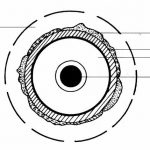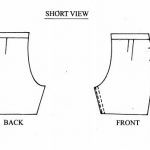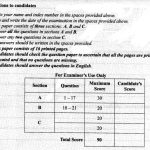KNEC KCSE Past Papers 2018 History and Government (311/1)
Kenya certificate of secondary education
History and Government paper 1
SECTION A (25 marks)
Answer all questions in this section
1. Name the last stage in the evolution of man.(1 mark)
2. Which is the largest linguistic group in Kenya’?(1 mark)
3. Give two sub-groups of the Mjikenda.(2 mark)
4. Highlight one way of becoming a citizen in Kenya.(1 mark)
5. Identify two activilies that promote national unity in Kenya. (2 marks)
6. State two natural factors that were responsible for the rise of Nairobi as an urban centre.(2 marks)
7. Give two types of constitutions.(2 mark)
8. State two types of democracy. (2 marks)
9. Name the leader of the Wanga who collaborated with I he British.(1 mark)
10. Name two methods which were used by Ihe Brit ish to eslablish llieir rule in Kenya. (2 marks)
11. Name two groups which were involved in t)ie provision of education services in Kenya during the colonial period.(2 marks)
12. State the importance of Eliud Matliu in the history or Kenya.(1 mark)
13. Give two national philosophies in Kenya.(2 mark)
14. Who is the adm inistrative head of the Parliamentary Service Commission?(1 mark)
17. Ganse one category o1 eiectcd lreirbers of tirà National Assembly in Kenya.(1 mark)
SECTION B (45 marks
Answer any three questions from this section in the space provided at the end of question 4
18. (a) State five reasons that led to the migration Of the Luo from their original homeland to the present day Kenya. (5 marks)
(b) Describe five aspects of the social organisation of the Agikuyu in the 19″ century, ( 10 marks)
19. (a) Give five reasons that led to the corning of the Arabs to the Kenyan Coast. (5 marks)
(b) Explain five effects of Cloistian missionary activities in Kenya. (10 marks)
20. (a) Identify five roles of chiefs during the colonial period in Kenya. (5 marks)
(b) Explain five factors responsible for’ the Agiryama reistance to the British rule in Kenya.(10 marks )
21. (a) Give five political contributions by Ronald Ngala. (5 marks)
(b) Discuss five reasons thai led to thc emergence of independent churches and schools in Kenya during the colonial period. ( 10 marks)
SECTION C (30 marks)
Answer any two questions from this section in the space provided at the end of question 24
22. (a) Name three cate8ories of members who make up a County Assembly in Kenya. (3 marks)
(b) Explaln six functions of retumin8 officers in a general election in Kenya. ( 2 marks)
23. (a) State three reasons why the independence of the Judiciary is important in Kenya.(3 marks)
(b) Explain six factors that can interfere with free and fair elections in Kenya. ( 2 marks)
24. (a) State three roles of the CommiSslon on Revenue Allocation (C.R.A).(3 mark)
(b) Discuss six features of the Constitution of Kenya (2010).(12 mark)
Questions and Answers
History and Government paper 1
1. Name the last stage in the evolution of man.(1 mark)
Homo Sapiens Sapiens
2. Which is the largest linguistic group in Kenya ?(1 mark)
Bantu
3. Give two sub-groups of the Mjikenda.(2 mark)
(i) Kauma
(ii) Giriama
(iii) Duruma
(iv) Chonyi
(v) Jibania
(vi) Kambe
(vii) Ribe
(viii) Rabai
(ix) Digo
4. Highlight one way of becoming a citizen in Kenya.(1 mark)
(l) By birth.
(ii) By registration.
5. Identify two activilies that promote national unity in Kenya. (2 marks)
(i) Agricultural shows/trade fairs.
(ii) Games and sports.
(iii) National holidays.
6. State two natural factors that were responsible for the rise of Nairobi as an urban centre.(2 marks)
(i) It had good climate/cool temperatures.
(ii) The presence of water/Nairobi river.
(iii) It had level ground/flat terrain.
7. Give two types of constitutions.(2 mark)
(i) Written constitution.
(ii) Unwritten constitution.
8. State two types of democracy. (2 marks)
(i) Constitutional/liberal.
(ii) Direct/pure.
(iii) Indirect/responsive
9. Name the leader of the Wanga who collaborated with the British.(1 mark)
Nabongo Mumia
10. Name two methods which were used by Ihe British to establish their rule in Kenya. (2 marks)
(i) Collaborations.
(ii) Military expeditions.
(iii) Signing of treaties.
(iv) Company rule.
(v) Use of operational bases.
11. Name two groups which were involved in the provision of education services in Kenya during the colonial period.(2 marks)
(i) Christian missionaries.
(ii) Colonial government.
(iii) Asians.
(iv) Africans.
12. State the importance of Eliud Mathu in the history of Kenya.(1 mark)
He was the first African to be elected to the Legislative Council (LegCo).
13. Give two national philosophies in Kenya.(2 mark)
(i) African Socialism.
(ii) Harambee.
(iii) Nyayoism.
14. Who is the administrative head of the Parliamentary Service Commission?(1 mark)
The Clerk to the National Assembly/Clerk
17. Give one category of electcd members of the National Assembly in Kenya.(1 mark)
(i) Constituency Representatives/Members of Parliament.
(ii) Women Representatives.
SECTION B (45 marks
Answer any three questions from this section in the space provided at the end of question 4
18. (a) State five reasons that led to the migration Of the Luo from their original homeland to the present day Kenya. (5 marks)
(i) Due to drought/famine.
(ii) Due to spirit of adventure.
(iii)Due to population pressure.
(iv)Due to internal conflicts/feuds.
(v) Due to outbreak of diseases/epidemics.
(vi)They were searching for better fishing grounds.
(b) Describe five aspects of the social organisation of the Agikuyu in the 19th century, ( 10 marks)
(i) They had a family which was the smallest unit headed by a father.
(ii) They had clans made up of several families who shared a common ancestry.
(iii) They had initiation for boys and girls/circumcision which was a rite of passage from childhood to adulthood.
(iv) They had age-set system/riika, which was composed of people initiated at the same time.
(v) They believed in the existence of one God, Ngai whom they believed to dwell on Mt. Kirinyaga (Kenya).
(vi) They had diviners who used to interpret God’s message to the people.
(vii) They had medicinemen/m«rtd« mugoZ anda ago whose main role was to cure sick members of the community.
(viii) They had designated worship places mainly under mugomo tree which operated as shrines/where they offered sacrifices.
(ix) They believed in the existence of ancestral spirits whom they honored by pouring libation so as to appease them.
19. (a) Give five reasons that led to the corning of the Arabs to the Kenyan Coast. (5 marks)
(i) They came as refugees/fleeing religions/political persecution in Arabia.
(ii) They came to establish settlements.
(iii) They wanted to trade/control commercial activities.
(iv)They came to spread Islam.
(v) They came to explore.
(b) Explain five effects of Christian missionary activities in Kenya. (10 marks)
(i) African culture/practices like polygamy changed with Africans adopting monogamy.
(ii) Western education/civilization spread with the opening up of schools like Alliance High School/Maseno which were centres for the spread of formal education.
(iii) Christianity spread broadly resulting into some Africans abandoning their traditional religious beliefs/practices.
(iv) Mission education created jobs among the educated thus creating gap/major difference between those who were schooled and the illiterate.
(v) They built hospitals/dispensaries which ensured provision of medical services.
(vi)They resulted to the development of agricultural/technical skills by training Africans in industrial skills. carpentry/masonry/introduced new farming methods.
(vii) They led to the formation of independent churches and schools to accommodate Africans v hose children could not be admitted/acccpted in mission schools.
(viii) They led to the abolition of slave trade/establishment of freed slave centres such as Freetori near Mombasa.
(ix) They promoted exploration of East Africa as they discovered mountains, lakes/drew maps of the region which assisted latter explorers.
(x) They contributed to the promotion of imperialism as missionaries opened the way for the colonialism to come and rule Kenya/the flag followed the cross.
(xi) African representation was boosted as missionaries were allowed to represent their interest in the Legislative Council (LegCo)/ Devonshire White Paper of 1923.
20. (a) Identify five roles of chiefs during the colonial period in Kenya. (5 marks)
(i) Maintenance of public order.
(ii) Hearing of petty cases.
(iii)C1earing of roads/footpaths.
(iv)Co1lection of taxes.
(v) To control the brewing of illegal liquor/cultivation of poisonous plants/carrying of weapons.
(b) Explain five factors responsible for’ the Agiryama reistance to the British rule in Kenya.(10 marks )
(i) Forced labour in the European plantation which meant neglecting their own farms/loss of profits which they used to get by selling their farm products.
(ii) Rape of Agiryama women by the colonial policemen at Vitengeni which was a provocative action against them.
(iii) Land alienation West of Sabaki River, meaning that the Agiryama would dwell on less productive areas, leaving the best land for the European settlement.
(iv) Interruption of their trade with the Swahili/Arab traders which had been their economic main stay for a long time.
(v) Interference with their traditions/religion/customs by demolishing their shrines which they regarded as sacred.
(vi) Forced taxation which meant that Africans had to work on the European farms so as to raise the hut tax charged.
21. (a) Give five political contributions by Ronald Ngala. (5 marks)
(i) He participated in formation of coalition government in 1962.
(ii) He was a leader of position/President of Kenya African Democratic Union (KADU).
(iii)He was the first President of the Coast Regional Association.
(iv) He was a Member of African Elected Members Organisation (AEñIO).
(v) He was Minister for labour, social security and Adult Education.
(vi)He pushed/advocated for/fought for Majimbo system of government.
(b) Discuss five reasons thai led to thc emergence of independent churches and schools in Kenya during the colonial period. ( 10 marks)
(i) The Africans wanted a free environment where they could practice Christianity and still keep some cultural practices/polygamy which were forbidden by missionaries.
(ii) Africans wanted better education which could give them better opportunities as opposed to that provided by the Europeans which only gave them low position jobs in government offices.
(iii) The Africans felt discriminated against the missionaries as they were denied leadership position in the church.
(iv) Due to European alienation of their land, the Africans wanted an education system which gave them better economic status.
(v) Some Africans perceived White missionaries as colonialist since they paved way for the colonia1ists/the flag followed the cross.
(vi) The Africans wanted to create an enabling environment without European interference who did not allow them to participate in government affairs.
SECTION C (30 marks)
Answer any two questions from this section in the space provided at the end of question 24
22. (a) Name three cate8ories of members who make up a County Assembly in Kenya. (3 marks)
(i) Elected ward representatives/MCAs).
(ii) Nominated members.
(iii) The Speaker who is ex-officio.
(b) Explain six functions of returning officers in a general election in Kenya. ( 2 marks)
(i) They receive nomlnation papers from prospective candidates in wards/constituencies/counties / country’s presidential candidates.
(ii) They set up polling stations/booths in each polling station where voting talces place.
(iii)They distribute ballot papers/ boxes to all polling stations which arc manned by presiding officers.
(iv) They supervise votlng and counting of votes in the constituency.
(v) They receive/tally/verify constituency poll results before announcing them.
(vi) They appoint presiding officers who are put in charge of polling statlons.
(vii) They tally the presidential results from the constituencies/counties and relay them to the National Tallying Centre.
23. (a) State three reasons why the independence of the Judiciary is important in Kenya.(3 marks)
(i) It helps in ihe provision of services efficiently/effectively.
(ii) It safewmds itself from abuse by the Legis1ature/ Executive.
(iii) It en2bles the courts to interpret the law without fear, favour or pressure/any form of influence.
(iv) It is the basis of the Rule of Law.
(v) It ensures people enjoy their rights/freedoms.
(b) Explain six factors that can interfere with free and fair elections in Kenya. ( 2 marks)
(i) Corruption among electoral officials/other players, which compromises fairness of the electoral process.
(ii) Election violence during the election period, which may discourage/turn away potential voters from exercising their democratic right of voting.
(iii) Illiteracy of some voters may make them easily misled when voting/exposes them to the danger of being misled.
(iv) Incompetent election officials can mismanage the process thereby undermining its effectiveness.
(v) Rigging may interfere with elections where the wrong candidate is declared the winner/right candidate is denied victory.
(vi) Lack/inadequate civic education denies the electorate opportunity to learn about the importance of participating in elections.
(vii) Poor physical infrastructure where some polling stations may be inaccessible and hence denying voters in such areas a chance to vote.
(viii) Harassment of voters by supporters of different candidates/parties can prevent voters from voting in certain regions/ strongholds/zones.
(ix) Electoral equipment like BVR Kits can breakdown during elections thereby slowing down the process.
24. (a) State three roles of the CommiSslon on Revenue Allocation (C.R.A).(3 mark)
(i) Making recommendations concerning basis for equitable sharing of resources.
(ii) Making recommendations on matters concerning the financing of/financial management by County governments.
(iii) To define/enhance the revenue sources of the National and County Governments.
(iv) To encourage fiscal/ financial responsibility.
(v) To determine/publish/regu1ar1y review policy which sets out criteria for identifying the marginalized areas.
(b) Discuss six features of the Constitution of Kenya (2010).(12 mark)
(i) Sovereignty of the people and supremacy of the Constitution.
(ii) The Republic which is sovereign multiparty democratic state founded on national values and principles illustrated within the Constlr’ation. Citizenship and its entit1emcnts like passport/any documents of registration. The Bill of Rights which guarantees enjoyment of the rights fundamental freedoms entitled to everyone.
(v) The land and environment; land shall be held, used and managed in an equitable, efficient, productive and sustainable manner.
(vi) Leadership and integrity which stipulates the expected conduct of public officers.
(vii) Representation of the people which provides guiding principles to the electoral processes in the country /including the method of conducting elections/qualifications of candidates.
(Viii) The Legislature which is the law making body in the country.
(IX) The Executive which deals with the execution of the law/implementing government policies.
The Judiciary which comprises of the courts of law and judicial officers and deals with the interpretation of the law and administration ofjustice.
(xi) Devolved government which comprises the County Assembly and County Executive.
(Xii) Public finance where a Consolidated Fund is developed and into which all money is paid.
(xiii) The Public Service which enhances high standards of professional ethics/effective economic use of resources.
(xiv) National security which states that sccurity agencies shall exist and their roles clearly stipulated.
(xv) There are independent commissions and offices such as IEBC, C.R.A., and Police Service Commission whose functions are clearly spelt out.
(xvi) Amendment of the Constitution which stipulates ways of effecting amendments.
(XVii) It provides General Provisions which gives guidelines on enforcement/interpretation of the Constitution.
Transition and Consequential provisions which contain definitions of terms used in the Constitution.




